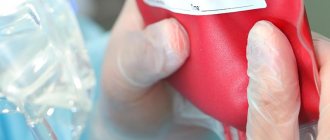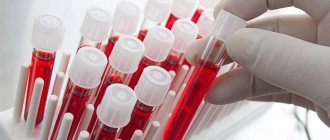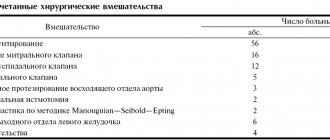Sometimes cancer patients require blood transfusions. If the doctor said that he plans to prescribe a blood transfusion, the patient usually has a lot of questions. Why is the procedure needed? Did something terrible happen? How safe is blood transfusion? Can you get HIV and other dangerous infections from a donor? How will the body react to someone else's blood? Will there be any complications? Is it possible to refuse the procedure or replace it with something else? [1,2]
Below you will find answers to many questions.
- What you need to know about blood?
- In what cases do cancer patients need blood transfusions?
- What are the types of blood transfusion?
- Red blood cell transfusion
- Plasma transfusion
- Platelet transfusion
- Cryoprecipitate transfusion
- Leukocyte transfusion
- How is the blood transfusion procedure performed?
- From whom can a blood transfusion be given?
- How is donor blood tested?
- Are there any alternatives?
- How safe is it?
- Is it possible to refuse a blood transfusion?
- Price
What you need to know about blood?
Doctors and scientists often refer to blood as the body's internal environment. It washes all organs. Blood performs many important functions: it carries oxygen, nutrients and hormones, removes waste products of metabolism, provides immune protection, and helps regulate body temperature.
Blood consists of two main parts:
- The liquid part is plasma. It is a solution of salts, ions, proteins and other substances.
- Blood cells. Erythrocytes (red blood cells) contain hemoglobin and transport oxygen. Leukocytes (white blood cells) provide nonspecific and immune protection. Platelets (blood platelets) form a clot when bleeding needs to be stopped. [1,3,4]
Book a consultation 24 hours a day
+7+7+78
In what cases do cancer patients need blood transfusions?
The cause may be the malignant tumor itself or side effects of antitumor treatment.
Some types of cancer, especially tumors of the gastrointestinal tract and tumors of the female genital area (vagina, cervix, uterus), can cause internal bleeding.
With a long course of cancer, various disorders occur in the body, which cause the so-called anemia of a chronic disease.
Some malignant tumors affect the red bone marrow (the main organ of hematopoiesis), or organs that are necessary to maintain a normal number of blood cells (spleen, kidneys). These types of cancer may also require blood transfusions.
Donor blood is needed by patients after complex operations that are accompanied by large blood loss.
Chemotherapy and radiation therapy affect not only tumor cells, but also other rapidly dividing cells in the body. Sometimes they cause quite a lot of damage to the red bone marrow. It disrupts the production of blood cells, which threatens anemia, bleeding, and severe infections against the background of decreased immunity. Blood transfusion helps normalize the patient's condition and prevent complications. [5-7]
Indications and contraindications for blood transfusion
Even though preparation for the blood transfusion process is carried out according to all the rules, this procedure still provokes sensitization of the body. Moreover, there is always a risk of immunizing the body with antigens that modern medicine does not yet know about. Therefore, there are practically no indications for whole blood transfusion.
The only exceptions may be the following situations:
- Acute blood loss in a person, when its total volume is about 15% of the total circulating blood volume.
- Bleeding due to a violation of the hemostatic system. If possible, the patient is transfused not with whole blood, but with the necessary elements.
- State of shock.
- Severe anemia.
- Trauma or complex surgery, which is accompanied by massive blood loss.
Hemotransfusion with whole blood has many more contraindications to its implementation than indications. The main contraindications are a wide variety of diseases of the cardiovascular system. However, when it comes to transfusion of red blood cells or other individual blood elements, absolute contraindications often become relative.
So, absolute contraindications to whole blood transfusion include:
- Septic endocarditis in subacute and acute stages.
- Thrombosis and embolism.
- Cerebral circulation disorders of pronounced intensity.
- Pulmonary edema.
- Myocarditis and myocardiosclerosis.
- The third stage of arterial hypertension.
- Third and 2B degree of circulatory disorders.
- Atherosclerosis of cerebral vessels.
- Nephrosclerosis.
- Hemorrhages in the retina of the eye.
- Rheumatism in the acute stage, rheumatic fever.
- Kidney and liver failure in acute and chronic stages.
Relative contraindications:
- Amyloidosis.
- Disseminated pulmonary tuberculosis.
- Hypersensitivity to proteins and protein preparations.
- Allergy.
If a situation arises that poses a direct threat to a person’s life, then they do not pay attention to absolute contraindications. After all, there are cases when, without a speedy blood transfusion, a person will simply die. However, even then, it is highly advisable to transfuse the patient not with whole blood, but with its individual components, for example, red blood cells. Doctors also try to replace the blood with special solutions as much as possible. In parallel, the patient is indicated for the administration of antiallergic drugs.
Red blood cell transfusion
The main function of erythrocytes (red blood cells) is the delivery of oxygen to tissues and the return transport of carbon dioxide to the lungs. A condition in which the number of red blood cells in the blood decreases is called anemia. Actually, this is an indication for red blood cell transfusion. The doctor makes a decision depending on how quickly the anemia increases:
- With chronic anemia, which increases gradually, there is no need to rush. The doctor monitors the patient’s condition, controls the level of red blood cells and hemoglobin. If these indicators decrease significantly, or the patient’s condition worsens, red blood cells are transfused. For heart and lung diseases that impede oxygen delivery to tissues, transfusions may be required even if there is a relatively small decrease in hemoglobin levels.
- Acute blood loss requires immediate action. This usually happens during surgery. If the doctor is planning a complex operation during which the patient will lose a lot of blood, blood transfusion may be performed in advance. [8]
Red blood cell mass
How long does the effect last after a blood transfusion?
Everyone knows that blood transfusion is a medical procedure that saves the life of many patients in extreme and difficult situations and prolongs it for cancer patients. But the blood transfusion system is not at all simple. At the first stage, 250-300 ml of red blood cells are administered and the vital signs of the body are monitored. If red blood cells and hemoglobin have returned to normal, the next blood transfusion is carried out no earlier than 18-30 days later, provided that the red blood cell has not recovered during this period of time.
In a situation where, due to the constant destruction of pathological tissues of the neoplasm, daily blood loss occurs, transfusion is performed in the amount of 2-3 doses of red blood cells every 5-7 days. This situation is typical for cervical or vaginal cancer. The procedure will be repeated until conditions are created that are suitable for embolization of the vessels feeding the tumor, or for surgical treatment or chemotherapy.
Plasma transfusion
Plasma, the liquid part of blood, appears as a clear, yellowish liquid. It contains blood clotting factors - substances that are necessary for the formation of a blood clot and stop bleeding. Plasma also contains substances that protect the body from infection.
Plasma can be stored frozen for up to 12 months. When necessary, it is thawed and the resulting fresh frozen plasma is transfused into the patient.
The main indication for plasma transfusion in cancer patients is increased bleeding. The procedure is also necessary for DIC syndrome (disseminated intravascular coagulation syndrome) - a serious condition in which blood clots form in small vessels, ultimately depleting the entire supply of platelets and coagulation factors, and there is a risk of severe bleeding. [9-10]
Blood plasma transfusion
Why do cancer patients need transfusions?
Due to chemotherapy, radiation treatment, tumor disintegration, accompanied by blood loss, the composition of the blood of cancer patients changes. The number of red blood cells, platelets, and plasma proteins decreases. The functioning of the whole organism depends on these indicators; as a result, cancer patients feel worse and lose strength. In such cases, blood transfusion helps.
A growing tumor releases substances that reduce the iron content (hemoglobin) and shorten the life of red blood cells. In addition, it can grow into the walls of blood vessels, causing chronic bleeding. For this reason, the patient cannot undergo chemotherapy, radiation treatment or surgery. We have to postpone vital procedures due to a decrease in hemoglobin and red blood cells.
In such cases, blood transfusion is started, pursuing the following goals:
- improve red blood cell and platelet counts in order to begin treatment;
- normalize blood composition after treatment with chemotherapy and radiotherapy.
Platelet transfusion
Platelets, or blood platelets, take part in the formation of a blood clot and stop bleeding. Their levels may drop due to chemotherapy, radiation therapy, or if the tumor has replaced normal red bone marrow tissue. Platelet transfusions are usually required for cancer patients in one of three cases:
- if the level of platelets in the blood has fallen below a critical value;
- if there is increased bleeding, risk of bleeding;
- if you are undergoing surgery during which significant blood loss is expected. [11,12]
Platelet mass
How is the blood transfusion procedure performed?
Although blood transfusion is formally equated to surgical interventions, this procedure is not at all scary and is practically painless. Blood transfusion is carried out through a needle that is inserted into a vein. It is no more painful than a regular intravenous injection. If the patient already has a central venous catheter, donor blood can be administered through it.
The procedure can take different times, depending on which blood components are transfused: from 30-60 minutes (platelet transfusion) to 2-4 hours (red blood cell transfusion).
Ways and methods of blood transfusion
There are several methods of blood transfusion, each of which is designed to achieve specific goals and objectives.
Among them:
- Indirect transfusion, when the patient is transfused with donor blood stored in certain containers.
- Direct blood transfusion, when the patient is transfused with blood directly from a donor vein. This procedure is carried out using special equipment. The device makes it possible to perform continuous blood transfusion, and with the help of a syringe, intermittent transfusion is performed.
- Exchange transfusion, when blood is transfused to a patient after his blood has been partially or completely removed.
- Autohemotransfusion. In this case, the patient is transfused with pre-prepared donor blood during surgery. In this case, the donor and the patient are one and the same person.
- Reinfusion. In this case, a person’s own blood, which was spilled during an accident or during an operation, is collected and then transfused to the person himself.
Blood is transfused by drip, stream or stream-drip. The doctor must decide on the speed of the transfusion.
Blood transfusion is a complex procedure that is compared to surgery, so its implementation is within the competence of the doctor, and not the junior medical staff.
Methods of donating blood to the recipient:
- Intravenous infusion is the basic method of blood transfusion. Venipuncture is a standard blood transfusion, while venesection is a method of transfusing blood through a catheter that is inserted into the subclavian vein. The device can remain in this place for a long time, but the catheter must be properly cared for.
- Intra-arterial blood transfusion is performed very rarely when a person experiences cardiac arrest.
- It is possible to perform intraosseous blood transfusion. The most commonly used bones for this purpose are the sternum and ilium. Less commonly, blood is injected into the heel bones, the condyles of the femurs and the tuberosity of the tibia.
- Intracardiac blood transfusion is performed into the left ventricle. This method of blood transfusion is implemented in practice extremely rarely, when other methods are not available.
- Intra-aortic transfusion can be performed when there are only a few seconds to save a person's life. Indications may include: unexpected clinical death, massive blood loss during surgery in the sternum.
It is important to distinguish between autohemotransfusion and autohemotherapy, since these are two radically different procedures. During autohemotransfusion, a person is given a full transfusion of his own blood, which was previously collected. In autohemotherapy, a transfusion of the patient's own blood is performed from a vein into the buttock. This procedure is aimed at eliminating cosmetic defects, for example, youthful acne, pustular skin lesions, etc.
How is donor blood tested?
A person who donates blood for the first time must fill out a questionnaire, undergo an examination by a therapist, a dermatovenerologist, and take tests for blood type, Rh factor, and infections: HIV, viral hepatitis B and C, syphilis, cytomegalovirus. Sometimes the examination program can be expanded.
If signs of a particular infection are found in the donor’s blood, it is discarded and not used in the future.
The compatibility of the blood of the donor and the recipient is checked using a special test - a cross-blood compatibility test.
Oncology clinic in Moscow
Oncology clinic in Moscow ¦ BLOOD TRANSFUSION FOR CANCER PATIENTS ¦ Indications for blood transfusion
Blood transfusion in the European clinic
Hemotransfusion is the transfusion of blood and its components in order to restore lost formed elements and blood plasma proteins by the patient's body. For some severe somatic diseases, this procedure is in great demand and can literally save the patient’s life.
At the European Clinic of Surgery and Oncology, blood transfusion has become a routine procedure, since this institution has a mainly oncological profile and provides care to people even in terminal conditions in the context of palliative measures.
Together with the most modern methods of treatment and palliative care, transfusion helps quickly and effectively improve the well-being and quality of life of people hospitalized in the clinic.
| European Oncology Clinic Request for consultation and treatment +7(925)191-50-55 Moscow, Dukhovskoy lane, 22b |
Importance of Transfusion Method
Blood is an important component of the internal environment of the body. Through the system of main and peripheral vessels, blood carries various substances and formed elements to all organs and tissues.
Blood and the vascular system ensure the constancy of the internal environment of the human body. Platelets, interacting with blood coagulation factors, prevent blood loss by activating hemostatic mechanisms.
Excessive thrombus formation, fraught with embolism, is stopped by proteins of the anticoagulation system. It is known that the blood contains a huge amount of hormones, growth factors and other regulators that duplicate the nervous system, distributing chemical signals to various organs and modulating their activity.
Through feedback, peripheral tissues communicate with the central nervous system and the overlying cascade in the hormonal hierarchy of the endocrine glands.
Immune molecules and white blood cells dissolved in the blood ensure the neutralization of foreign microbes and non-microbial factors that can destroy and destroy the body.
Red blood cells containing hemoglobin ensure continuous oxygenation of every cell in the body. The plastic and energy components of food that have been broken down in the digestive tract are transported through the blood.
Thus, we can summarize that blood is a complex biological fluid critical for survival, ensuring the existence and normal functioning of the entire body.
The loss of any of the blood components is most often incompatible with the concept of health, and sometimes even life. Most of the formed elements of blood are synthesized in the bone marrow, and soluble components are synthesized in the liver, kidneys, endocrine glands and other cells of the body.
Pathology on the part of any of these organs, for obvious reasons, changes the composition of the blood. The integrity of blood vessels is very important for biological functions, since restoring lost blood volume requires time and resources.
Hematotransfusion is a method that allows you to quickly restore blood loss or individual lost blood fractions and eliminate a life-threatening condition.
Blood transfusions were invented back in the 17th century, but they began to be used meaningfully after 1901, when Karl Landsteiner discovered blood groups, for which he was awarded the Nobel Prize.
The antigenic composition of each person's blood is individual, but the most critical for transfusiology are blood group antigens, Rh factor and Kell antigens. Their identity between the donor and the recipient solves many problems in transfusiology. If the blood is not compatible, then the donor's antibodies can destroy the recipient's red blood cells and vice versa.
Massive hemolysis leads to a sharp release of breakdown products and hemoglobin into the vascular bed and has a fatal effect on the kidneys, causing renal failure and sometimes even death.
All these features are taken into account when choosing blood and its components for transfusion to a given patient.
The blood transfusion procedure should be preceded by the determination of antigens in the blood of the donor and recipient, as well as a biological test, in which 15 ml of donor blood is first injected into a vein, wait 10 minutes, and if there is no reaction, the main transfusion is performed. The procedure can take from half an hour to 3 hours.
When is blood transfusion prescribed?
The most common indication for blood transfusion is anemia, in which hemoglobin falls below 70 g/l. This happens with acute or chronic blood loss of traumatic, oncogenic and other origin.
Cancer patients are most often transfused not with whole blood, but with erythromass, since whole blood can provoke metastasis and a decrease in the body's defenses.
The fact is that decay products enter the body along with blood, since in the process of taking and storing donor blood, some of the formed elements are destroyed.
Sometimes blood is transfused the day before or during surgery if significant blood loss occurs. In the latter case, the patient is transfused with his own blood and this procedure is called autohemotransfusion. It is well tolerated as there is no antigenic conflict.
Another indication for blood or plasma transfusion may be a blood clotting disorder. This can be observed in diseases of the liver, which synthesizes coagulation factors or after massive blood loss, with disseminated intravascular coagulation.
Sometimes, instead of plasma and blood, plasma cryoprecipitate, in which all protein factors are in increased concentration, or a platelet suspension is transfused.
Blood transfusion from a healthy donor or leukomass is prescribed for serious disorders in the immune system, which are manifested by severe inflammatory diseases and intoxication against their background.
As a rule, such a patient’s own leukocytes are anergic and lose the ability to effectively fight infection.
The introduction of active immune cells allows one to cope with severe pathologies and neutralize microbial agents.
Transfusion is also indicated for traumatic shock and some poisonings, which may be accompanied by protein imbalance in the bloodstream and hemolysis.
In case of regeneration disorders (for example, against the background of chronic inflammation), blood transfusion also helps well, since growth factors and others that stimulate proliferation and healing molecules enter the patient’s body.
Contraindications to blood transfusion
An absolute contraindication is heart failure with the appearance of alveolar effusion. Additional blood supply increases the total fluid content in the bloodstream and, consequently, the hemodynamic load on the heart, which aggravates heart failure.
However, in the event of a critical drop in hemoglobin, transfusion is still carried out under careful hardware monitoring and medical supervision.
It is extremely undesirable to carry out blood transfusions in cases of high blood pressure, a tendency to thromboembolism, renal and liver failure, a burdened history of allergies, or inflammatory processes in the heart.
However, these contraindications are relative and, if the risks from blood loss exceed those from possible complications, then a transfusion is still performed, since in a critical situation only it can save the patient’s life.
| European Oncology Clinic Request for consultation and treatment +7(925)191-50-55 Moscow, Dukhovskoy lane, 22b |
| Indications for blood transfusion |
| Plasma transfusion |
| Red blood cell transfusion |
| Platelet transfusion |
| Leukocyte transfusion |
+7(925)191-50-55 — European treatment protocols in Moscow
REQUEST TO THE CLINIC
Are there any alternatives?
Sometimes blood disorders can be corrected with medications. For example, colony-stimulating factors are used to increase the number of white blood cells.
However, in cases where blood transfusion is necessary, there are no alternatives. There are no blood substitutes that can provide similar effects. That is why donation is constantly promoted in all countries of the world, including Russia, and donor days are held periodically. It is important. This helps save the lives of many people. [15]
How safe is it?
Can you get an infection from donated blood? Donated blood goes through rigorous testing, but there are still risks, even though they are negligible. Thus, the likelihood of becoming infected with HIV through donated blood is lower than the likelihood of being struck by lightning during a person’s lifetime. The risk of contracting hepatitis C is 1 in 2,000,000. Doctors and scientists are constantly working to reduce the risks to zero. [16]
Can incompatible blood be transfused? Before blood transfusion, the recipient's blood type and Rh factor must be determined; the doctor must make sure that the blood of the donor and recipient are compatible.
But the blood of different people can differ not only in group A0 and Rh factor. It is very difficult to take into account all the nuances. Therefore there is a slight risk of an allergic reaction. Most often it manifests itself in the form of fever, chills, and rash. Such complications are rarely life-threatening. In order to provide assistance to the patient, if necessary, a medical professional is constantly monitoring his condition during the procedure.
An allergic reaction can occur not only immediately during the transfusion, but also within 48 hours after it. You should immediately tell your doctor if your body temperature rises above 38°C, chills, rash, itching, redness of the skin, shortness of breath, difficulty breathing, nausea, lower back pain, blood in the urine, weakness. The most dangerous symptom is chest pain, which requires immediate attention. If you are at home, you should immediately call an ambulance. [5]
How is it carried out?
During blood transfusion, the doctor must adhere to a certain algorithm, which consists of the following points:
- Determination of indications, identification of contraindications. In addition, the doctor asks the recipient whether he knows what group and Rh factor he has, whether there have been blood transfusions in the past, and whether there have been any complications. Women receive information about existing pregnancies and their complications (for example, Rh conflict).
- Determination of the patient's group and Rh factor.
- They choose which blood is suitable according to the group and Rhesus, and determine its suitability, for which a macroscopic assessment is made. It is carried out on the following points: correctness, tightness of packaging, expiration date, external compliance. Blood should have three layers: upper yellow (plasma), middle gray (leukocytes), lower red (erythrocytes). Plasma cannot contain flakes, clots, or films; it must only be transparent and not red.
- Testing of donor blood using the AB0 system from a bottle.
- Tests for individual compatibility in groups are required during blood transfusion at a temperature of 15°C to 25°C. How and why do they do it? To do this, place a large drop of the patient’s serum and a small drop of donor blood on a white surface and mix them. The assessment takes place in five minutes. If the red blood cells do not stick together, then it is compatible; if agglutination occurs, then the transfusion cannot be done.
- Rh compatibility tests. This procedure can be carried out in different ways. In practice, a test with 33 percent polyglucin is most often done. Centrifugation is carried out for five minutes in a special tube without heating. Two drops of the patient's serum and a drop of donor blood and polyglucin solution are dropped onto the bottom of the tube. Tilt the test tube and rotate it around its axis so that the mixture is distributed over the walls in an even layer. The rotation continues for five minutes, then add 3 ml of saline solution and mix, without shaking, but tilting the container to a horizontal position. If agglutination occurs, then transfusion is impossible.
- Carrying out a biological test. To do this, the recipient is injected with 10-15 ml of donor blood and his condition is monitored for three minutes. This is done three times. If the patient feels normal after such a check, the transfusion begins. The appearance of symptoms in the recipient such as shortness of breath, tachycardia, flushing of the face, fever, chills, abdominal and lower back pain indicates that the blood is incompatible. In addition to the classic biotest, there is a hemolysis test, or Baxter's test. In this case, 30-45 ml of donor blood is injected into the patient; after a few minutes, the patient’s blood is drawn from a vein, which is then centrifuged and its color is assessed. Regular color indicates compatibility, red or pink indicates the impossibility of transfusion.
- Transfusion is carried out by drip. Before the procedure, the bottle with donor blood must be kept at room temperature for 40 minutes, in some cases it is heated to 37°C. A disposable transfusion system equipped with a filter is used. Transfusion is carried out at a rate of 40-60 drops/min. The patient is constantly monitored. Leave 15 ml of medium in the container and store it in the refrigerator for two days. This is done in case an analysis is required due to complications that have arisen.
- Filling out a medical history. The doctor needs to write down the patient’s and donor’s group and Rh factor, data from each bottle: its number, date of preparation, donor’s last name and his group and Rh factor. The result of the bioassay must be entered and the presence of complications noted. At the end, indicate the name of the doctor and the date of transfusion, and put a signature.
- Monitoring the recipient after transfusion. After the transfusion, the patient must remain in bed for two hours and be under the supervision of medical personnel for 24 hours. Particular attention is paid to his well-being in the first three hours after the procedure. His temperature, pressure and pulse are measured, complaints and any changes in health are assessed, urination and urine color are assessed. The next day after the procedure, a general blood and urine test is performed.
Is it possible to refuse a blood transfusion?
The patient always has the right to refuse prescribed treatment, be it chemotherapy, surgery or blood transfusion. But you need to remember some points:
- A doctor will not prescribe a procedure, especially one as serious as a blood transfusion, just like that. If the doctor decides to perform a blood transfusion, then there are good reasons for this, and first of all it is in the interests of the patient.
- Large blood loss during surgery and significant blood disorders can lead to death or serious complications and impair the effectiveness of antitumor treatment.
- There are some risks during blood transfusion, but they are negligible, and the procedure often helps save the patient's life.
Euroonko clinics officially cooperate with the largest blood banks in the country. We operate on the basis of a license for “transfusiology in outpatient and inpatient settings” issued by the health departments of Moscow and St. Petersburg.
What is blood transfusion?
Blood for transfusion is taken from people voluntarily. This is carried out in medical institutions, in blood banks and blood transfusion stations. The blood that is taken from the donor is stored in containers so that it does not spoil; special preservatives and stabilizers are added to it. It is mandatory to test blood for various infectious diseases, such as HIV, gonorrhea, hepatitis. Various components are also extracted from the blood: red blood cells, plasma, platelets. Medicines are made from blood: gamma globulin, albumin, cryoprecipitate, etc.
The blood transfusion procedure is similar to the procedure of tissue transplantation from one person to another. It is simply impossible to select blood that is ideal in all respects, so whole blood is transfused very rarely. This only happens when the patient requires emergency direct blood transfusion. To ensure that the body has minimal side effects, the blood is divided into components. Most often they are red blood cells and plasma.
To prevent a person from becoming infected with dangerous infectious diseases such as HIV or hepatitis, the blood taken from the donor is sent to quarantine, where it is stored for 6 months. Conventional refrigerators are not suitable for this, since in such conditions the blood will lose its beneficial properties. Thus, platelets are stored for 6 hours, red blood cells can survive for no more than 3 weeks in the refrigerator, but after freezing they are destroyed. Therefore, the blood received from the donor is divided into red blood cells, which can be frozen at -196 °C using nitrogen. Blood plasma can also withstand ultra-low temperatures. The process of storing blood is very complex and requires a selective approach.
Most people who, due to their professional activities, are not associated with medicine, know only about the most common method of blood transfusion. In this case, blood from a container (vial or hemacon - a bag of blood and a preservative) is fed into the patient’s bloodstream through a puncture in a vein. A preliminary examination of the patient's blood is carried out to determine its group and Rh factor, if this is not known. Then he is infused with the blood that suits the person in all respects.
If previously it was believed that any blood is suitable for a person, the main thing is that it was obtained from a person, then modern medicine does not share this point of view. A compatibility test is required first.
Blood can be transfused from a donor to a recipient for the following purposes:
- Function of replacing one's own blood.
- Hemostatic function.
- Stimulating function.
- Removing intoxication.
- Nutritional function.
Carrying out blood transfusion requires caution on the part of the doctor. The procedure should be performed only if there are specific indications for it. Unjustified blood transfusion threatens serious health problems, because only identical twins have 100% blood compatibility. In other people, even though they are blood relatives, the blood differs in a number of individual indicators. Therefore, there is no guarantee that the body will not begin to reject it.
Price
- Consultation with a transfusiologist - 5100 rub.
- Complete blood count (CITO) - 2400 rub.
- Compatibility test before blood transfusion - 3,200 .
- Erythrocyte suspension, depleted of leukocytes (filtered) - 24,000 rub.
- Transfusion of blood components - 5300 rub.
- The cost of fresh frozen plasma (1 dose 250 ml) is 25,300 rubles.
- Platelet concentrate (1 dose) - 86,100 rub.
In accordance with the legislation of the Russian Federation (Law of the Russian Federation of June 9, 1993 N 5142-I “On the donation of blood and its components”), the procurement of blood, the receipt of blood components and their storage are carried out exclusively by state budgetary institutions. Blood transfusions to our patients are carried out on the basis of licenses for “transfusiology in outpatient and inpatient settings”.
Book a consultation 24 hours a day
+7+7+78
Bibliography:
- G.I. Kozin. Practical transfusiology. Practical medicine, Moscow 2005.
- Igonina M. E. Donate blood to save a life // BMIK. 2013. No. 2.
- O. A. Rukovitsyn. Hematology. National leadership. GEOTAR-Media.
- S. M. Lewis, B. Bain, I. Bates. Practical and laboratory hematology. Moscow, GEOTAR-Media, 2009.
- Seth Lotterman; Sandeep Sharma. Blood Transfusion. Treasure Island (FL): StatPearls Publishing; 2021 Jan-.
- Sandhya Yaddanapudi and LN Yaddanapudi. Indications for blood and blood product transfusion. Indian J Anaesth. 2014 Sep-Oct; 58(5): 538–542. doi: 10.4103/0019-5049.144648.
- Lawrence Tim Goodnough, MD and Anil K. Panigrahi, MD, PhDa. Blood Transfusion Therapy. Med Clin North Am. Mar 2021; 101(2): 431–447. Published online 2021 Dec 24. doi: 10.1016/j.mcna.2016.09.012.
- Giancarlo Liumbruno, Francesco Bennardello, Angela Lattanzio, Pierluigi Piccoli, and Gina Rossetti. Recommendations for the transfusion of red blood cells. Blood Transfus. 2009 Jan; 7(1): 49–64. doi: 10.2450/2008.0020-08.
- Ryan A. Lawless, MD and John B. Holcomb, MD Plasma Transfusion. Trauma Induced Coagulopathy. 2015 Dec 11: 323–337. Published online 2015 Dec 11. doi: 10.1007/978-3-319-28308-1_20.
- Giancarlo Liumbruno, Francesco Bennardello, Angela Lattanzio, Pierluigi Piccoli, Gina Rossetti, and as Italian Society of Transfusion Medicine and Immunohaematology (SIMTI) Working Party. Recommendations for the transfusion of plasma and platelets. Blood Transfus. 2009 Apr; 7(2): 132–150. doi: 10.2450/2009.0005-09.
- Atif I. Khan; FaizAnwer. Platelet Transfusion. Treasure Island (FL): StatPearls Publishing; 2021 Jan-.
- Neil Blumberg, Joanna M Heal and Gordon L Phillips. Platelet transfusions: trigger, dose, benefits, and risks. F1000 Med Rep. 2010; 2: 5. Published online 2010 Jan 27. doi: 10.3410/M2-5.
- B. Nascimento, L. T. Goodnough, and J. H. Levy. Cryoprecipitate therapy. Br J Anaesth. 2014 Dec; 113(6): 922–934. Published online 2014 Jun 27. doi: 10.1093/bja/aeu158.
- Juan Gea-Banacloche, MD. Granulocyte Transfusions: A Concise Review for Practitioners. Cytotherapy. 2021 Nov; 19(11): 1256–1269. Published online 2021 Sep 12. doi: 10.1016/j.jcyt.2017.08.012.
- A. A. Kerimov Blood transfusion: is there an alternative? // Biomedicine (Baku). 2004. No. 3.
- Polunina N.V., Gubanova M.N., Zhiburt Evgeniy Borisovich Risk of infection transmission during blood transfusion // Russian Medical Journal. 2021. No. 6.










